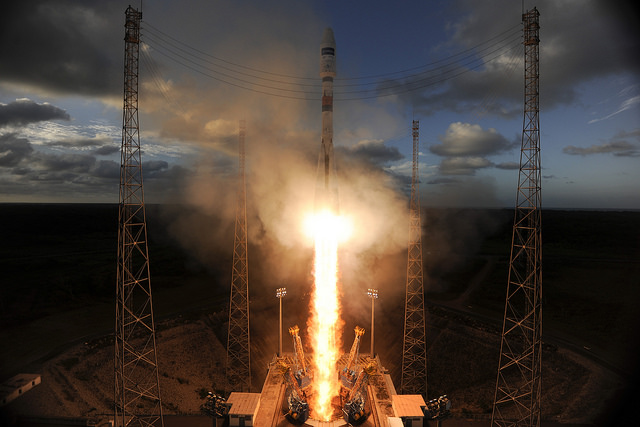

Photo credits:
ESA - S. Convaja, 2014
On 3 April 2014, Sentinel-1A was successfully launched on a Soyuz rocket from Europe's Spaceport in French Guiana.
The Sentinel-1 mission is the first of six families of dedicated missions that will make up the core of Europe’s Copernicus environmental monitoring network. Copernicus will provide operational information on the world’s land surfaces, oceans and atmosphere to support environmental and security policymaking and the needs of individual citizens and service providers.
During the launch, the 12m-long radar and two 10m-long solar wings were folded up to fit into the protective Soyuz rocket fairing. After being lofted to 693km above Earth and released into orbit, the satellite gently ‘tumbled’ to stabilise before embarking on its elaborate dance routine. The solar wings and radar opened together in a specific sequence that took around 10 hours to complete.
Sentinel-1A carries on board a Synthetic Aperture Radar (SAR) which emits radar pulses to the surface of the Earth and, using a highly sophisticated processing method, produces a high resolution image of a number of surface properties. SAR data provide important information on oil spills and icebergs for Marine Monitoring, polar caps, ice shelves and glaciers for Climate Change and ship detection for Security. By mapping areas stricken by flood or earthquake, the radar will also be able to help emergency teams identify the worst-hit areas and locate roads, railway lines and bridges that are still passable.
Furthermore, Sentinel-1A will continue the unique Wave Mode acquisition started by ERS-1 in 1991 which was interrupted 2 years ago when Envisat stopped working. The Wave Mode on Sentinel-1A is expected to provide much improved observations on ocean swell evolution and its decay. The poorly known swell dissipation is still the largest error source in ocean wave models and this type of global observations will be key to better understand swell decay.
The development of Sentinel-1A has been led by ESA, the EC's procurement agent responsible for the design of the satellites requirements.
Speaking from Europe's Spaceport in Kourou, ECMWF Director-General Professor Alan Thorpe, said:
"ESA’s successful launch of Sentinel 1 brings into service the first satellite in the Copernicus programme. Copernicus is a game-changer and a strong indication of how seriously the European Commission takes environmental services. The operational information it will deliver to policy-makers and to citizens will fundamentally change the way we manage our environment and tackle the effects of climate change. As a start of the Copernicus global monitoring programme, there could not have been a more powerful and inspiring way to illustrate the Commission’s ambition as well as the talent, expertise and capability it is gathering around the delivery of operational environmental services."
About ESA:
The European Space Agency (ESA) is an intergovernmental organisation, created in 1975. ESA's programmes are designed to find out more about Earth, its immediate space environment, our Solar System and the Universe, as well as to develop satellite-based technologies and services, and to promote European industries. ESA also works closely with space organisations outside Europe.
ESA has 20 Member States.
ESA is developing a new family of missions called Sentinels specifically for the operational needs of the Copernicus programme. Each Sentinel mission is based on a constellation of two satellites designed to provide robust datasets for Copernicus Services.
For more information about Sentinel, please visit the ESA website.
|
Sentinel selfie from space |
Sentinel-1A Lift Off |
|
Sentinel-1A Lift Off |
Sentinel-1A Lift Off |




